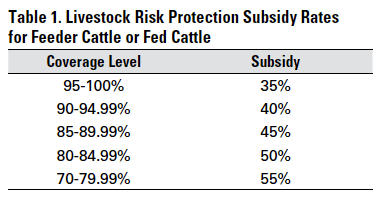Recognizing Livestock Risk Defense (LRP) Insurance: A Comprehensive Guide
Browsing the world of animals danger protection (LRP) insurance policy can be a complicated undertaking for many in the agricultural industry. From how LRP insurance policy functions to the various protection alternatives offered, there is much to reveal in this thorough overview that might potentially shape the way livestock producers come close to risk monitoring in their companies.

How LRP Insurance Functions
Sometimes, understanding the auto mechanics of Livestock Threat Protection (LRP) insurance can be intricate, but breaking down just how it works can provide clarity for ranchers and farmers. LRP insurance is a risk administration tool created to safeguard livestock producers versus unforeseen rate declines. The policy permits manufacturers to set an insurance coverage degree based upon their certain demands, choosing the number of head, weight range, and protection rate. Once the plan remains in place, if market value drop below the protection cost, producers can file a case for the difference. It is very important to keep in mind that LRP insurance coverage is not an earnings guarantee; instead, it focuses only on rate risk security. The insurance coverage duration generally ranges from 13 to 52 weeks, supplying adaptability for producers to choose a duration that lines up with their manufacturing cycle. By making use of LRP insurance, breeders and farmers can alleviate the financial threats connected with fluctuating market prices, making sure better security in their procedures.
Eligibility and Insurance Coverage Options

When it comes to insurance coverage alternatives, LRP insurance coverage supplies producers the adaptability to pick the insurance coverage level, insurance coverage period, and recommendations that ideal fit their risk administration requirements. By comprehending the eligibility criteria and insurance coverage choices available, livestock manufacturers can make enlightened choices to manage threat properly.
Advantages And Disadvantages of LRP Insurance
When evaluating Livestock Risk Defense (LRP) insurance coverage, it is vital for animals producers to evaluate the advantages and negative aspects inherent in this risk monitoring tool.

One of the key benefits of LRP insurance coverage is its capability to give defense versus a decrease in animals costs. Furthermore, LRP insurance coverage uses a degree of flexibility, permitting manufacturers to tailor insurance useful link coverage degrees and policy durations to suit their specific needs.
One constraint of LRP insurance is that it does not secure versus all types of dangers, such as disease break outs or all-natural calamities. It is vital for producers to meticulously evaluate their specific danger direct exposure and financial scenario to figure out if LRP insurance is the ideal risk monitoring tool for their procedure.
Recognizing LRP Insurance Policy Premiums

Tips for Making Best Use Of LRP Perks
Taking full advantage of the benefits of Livestock Danger Defense (LRP) insurance requires calculated planning and positive danger monitoring - Bagley Risk Management. To take advantage of your LRP coverage, consider the following suggestions:
Consistently Assess Market Problems: Stay informed about market trends and price fluctuations in the livestock industry. By keeping track of these elements, you can make educated decisions about when to purchase LRP coverage to shield versus possible losses.
Establish visit this page Realistic Protection Levels: When selecting coverage degrees, consider your manufacturing expenses, market value of livestock, and potential risks - Bagley Risk Management. Establishing reasonable insurance coverage levels guarantees that you are appropriately safeguarded without overpaying for unneeded insurance policy
Expand Your Coverage: Instead of counting exclusively on LRP insurance coverage, consider expanding your danger administration techniques. Combining LRP with various other danger management devices such as futures contracts or options can give detailed coverage against market unpredictabilities.
Evaluation and Change Coverage Consistently: As market problems change, occasionally evaluate your LRP insurance coverage to ensure it straightens with your present risk direct exposure. Adjusting protection degrees and timing of purchases can aid enhance your threat security approach. By complying with these tips, you can make the most of the advantages of LRP insurance and safeguard your livestock operation versus unforeseen risks.
Conclusion
To conclude, livestock danger protection (LRP) insurance coverage is a beneficial tool for farmers to handle the economic risks related to their animals operations. By comprehending just how LRP functions, eligibility and coverage choices, along with the benefits and drawbacks of this insurance, farmers can make informed decisions to protect their livelihoods. By very carefully taking into consideration LRP premiums and executing methods to make the most of benefits, farmers can alleviate possible losses and make certain the sustainability of their procedures.
Animals manufacturers interested in obtaining Livestock Risk Protection (LRP) insurance coverage can check out a variety of eligibility requirements and protection choices customized to their certain animals procedures.When it comes to protection choices, LRP insurance offers producers the versatility to select the protection level, protection period, and endorsements that best match their threat monitoring demands.To comprehend the ins and outs of Animals Danger Protection (LRP) insurance fully, recognizing the variables affecting LRP insurance coverage premiums is essential. LRP insurance costs are established official website by different aspects, consisting of the coverage degree selected, the expected rate of livestock at the end of the coverage duration, the type of animals being insured, and the length of the insurance coverage period.Review and Readjust Protection Frequently: As market conditions transform, periodically assess your LRP protection to ensure it straightens with your present threat direct exposure.